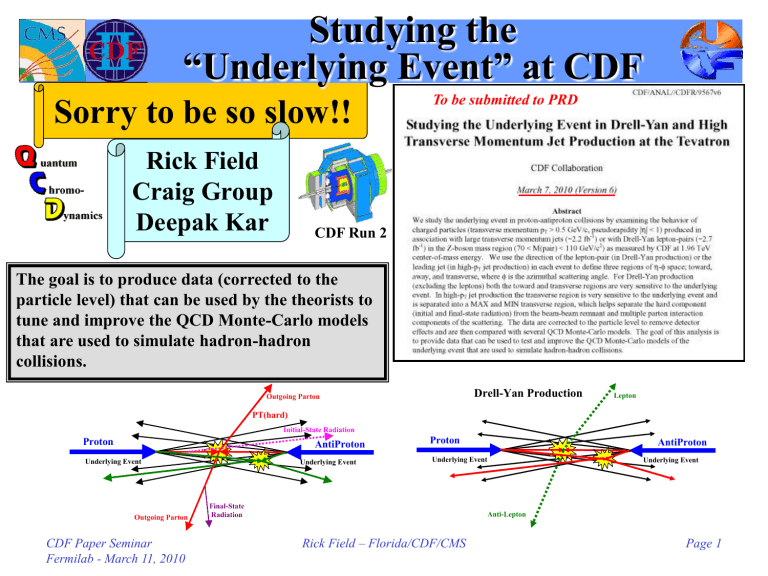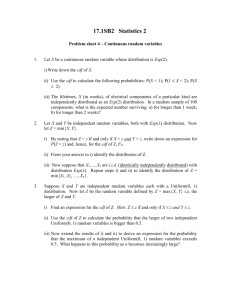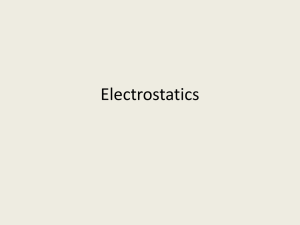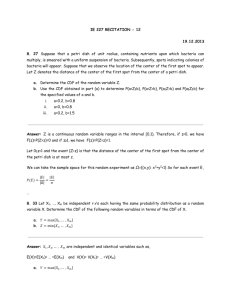Studying the “Underlying Event” at CDF Sorry to be so slow!! Rick Field
advertisement

Studying the “Underlying Event” at CDF Sorry to be so slow!! Rick Field Craig Group Deepak Kar To be submitted to PRD CDF Run 2 “Leading Jet” The goal is to produce data (corrected to the particle level) that can be used by the theorists to tune and improve the QCD Monte-Carlo models that are used to simulate hadron-hadron collisions. Drell-Yan Production Outgoing Parton Lepton PT(hard) Initial-State Radiation Proton AntiProton Underlying Event Outgoing Parton CDF Paper Seminar Fermilab - March 11, 2010 Underlying Event Proton AntiProton Underlying Event Final-State Radiation Underlying Event Anti-Lepton Rick Field – Florida/CDF/CMS Page 1 All use LO as with L = 192 MeV! UE Parameters ISR Parameter PYTHIA 6.2 Tunes Parameter Tune AW Tune DW Tune D6 PDF CTEQ5L CTEQ5L CTEQ6L MSTP(81) 1 1 1 MSTP(82) 4 4 4 PARP(82) 2.0 GeV 1.9 GeV 1.8 GeV PARP(83) 0.5 0.5 0.5 PARP(84) 0.4 0.4 0.4 Uses CTEQ6L Tune A energy dependence! PARP(85) of the 0.9 CDF 1.0 1.0 None Tunes included PARP(86) 0.95 1.0 1.0 any “min-bias” data in the PARP(89) 1.8 TeV 1.8 TeV 1.8 TeV PARP(90) 0.25 0.25 0.25 determination of the parameters! PARP(62) 1.25 1.25 1.25 PARP(64) 0.2 0.2 0.2 PARP(67) 4.0 2.5 2.5 MSTP(91) 1 1 1 PARP(91) 2.1 2.1 2.1 PARP(93) 15.0 15.0 15.0 Intrinsic KT CDF Paper Seminar Fermilab - March 11, 2010 Rick Field – Florida/CDF/CMS Page 2 All use LO as with L = 192 MeV! UE Parameters Tune A ISR Parameter PYTHIA 6.2 Tunes Parameter Tune DWT Tune D6T ATLAS PDF CTEQ5L CTEQ6L CTEQ5L MSTP(81) 1 1 1 MSTP(82) 4 4 4 PARP(82) 1.9409 GeV 1.8387 GeV 1.8 GeV PARP(83) 0.5 0.5 0.5 ATLAS energy dependence! PARP(84) 0.4 0.4 Tune B 0.5 Tune AW Tune BW These are “old” PYTHIA 6.20.33tunes! PARP(85) 1.0 1.0 There are tunes PARP(86) 1.0 new 6.420 1.0 0.66 by PARP(89)Skands 1.96 TeV TeV update 1.0 TeV of S0) Peter (Tune1.96 S320, PARP(90) 0.16 0.16 N324, 0.16 Peter Skands (Tune N0CR) PARP(62) 1.25 1.25 1.0 Hendrik Hoeth (Tune P329, “Professor”) PARP(64) 0.2 0.2 1.0 PARP(67) 2.5 2.5 1.0 MSTP(91) 1 1 1 PARP(91) Tune D PARP(93) Tune 2.1 DW 15.0 2.1 15.0 5.0 Tune D6T Intrinsic KT CDF Paper Seminar Fermilab - March 11, 2010 1.0 Tune D6 CMS Rick Field – Florida/CDF/CMS Page 3 QCD Monte-Carlo Models: High Transverse Momentum Jets Hard Scattering Initial-State Radiation Hard Scattering “Jet” Initial-State Radiation “Jet” Outgoing Parton PT(hard) Outgoing Parton PT(hard) Proton “Hard Scattering” Component AntiProton Final-State Radiation Outgoing Parton Underlying Event Underlying Event Proton “Jet” Final-State Radiation AntiProton Underlying Event Outgoing Parton Underlying Event “Underlying Event” Start with the perturbative 2-to-2 (or sometimes 2-to-3) parton-parton scattering and add initial and finalstate gluon radiation (in the leading log approximation or modified leading log approximation). The “underlying event” consists of the “beam-beam remnants” and from particles arising from soft or semi-soft multiple parton interactions (MPI). The “underlying event” is“jet” an unavoidable Of course the outgoing colored partons fragment into hadron and inevitably “underlying event” background to most collider observables observables receive contributions from initial and final-state radiation. and having good understand of it leads to more precise collider measurements! CDF Paper Seminar Fermilab - March 11, 2010 Rick Field – Florida/CDF/CMS Page 4 QCD Monte-Carlo Models: Lepton-Pair Production Lepton-Pair Production High PT Z-Boson Production Anti-Lepton Outgoing Parton Initial-State Initial-State Radiation Radiation High P T Z-Boson Production Lepton-Pair Production Initial-State Initial-StateRadiation Radiation “Jet” Proton Proton Final-State Radiation Outgoing Parton Anti-Lepton Final-State Radiation “Hard Scattering” Component AntiProton AntiProton Underlying Event Lepton Z-boson Underlying Event Proton Lepton Z-boson AntiProton Underlying Event Underlying Event “Underlying Event” Start with the perturbative Drell-Yan muon pair production and add initial-state gluon radiation (in the leading log approximation or modified leading log approximation). The “underlying event” consists of the “beam-beam remnants” and from particles arising from soft or semi-soft multiple parton interactions (MPI). Of course the outgoing colored partons fragment into hadron “jet” and inevitably “underlying event” observables receive contributions from initial-state radiation. CDF Paper Seminar Fermilab - March 11, 2010 Rick Field – Florida/CDF/CMS Page 5 “Towards”, “Away”, “Transverse” Look at the charged particle density, the charged PTsum density and the ETsum density in all 3 regions! Correlations relative to the leading jet Jet #1 Direction “Transverse” region is very sensitive to the “underlying event”! Charged particles pT > 0.5 GeV/c || < 1 Calorimeter towers ET > 0.1 GeV || < 1 “Toward-Side” Jet 2 Away Region Z-Boson Direction Jet #1 Direction Transverse Region “Toward” “Toward” “Transverse” “Transverse” “Away” “Transverse” “Transverse” Leading Jet Toward Region “Away” Transverse Region “Away-Side” Jet Away Region 0 -1 +1 Look at correlations in the azimuthal angle relative to the leading charged particle jet (|| < 1) or the leading calorimeter jet (|| < 2). Define || < 60o as “Toward”, 60o < || < 120o as “Transverse ”, and || > 120o as “Away”. o Each of the three regions have area = 2×120 = 4/3. CDF Paper Seminar Fermilab - March 11, 2010 Rick Field – Florida/CDF/CMS Page 6 “Towards”, “Away”, “Transverse” “Leading Jet” Jet #1 Direction “Toward” “Transverse” “Transverse” “Away” Charged PTsum Density (GeV/c) Average Charged Density Charged PTsum ParticleDensity: Density:dPT/dd dN/dd Charged 5 100.0 CDFCDF RunRun 2 Preliminary 2 Preliminary 4 data corrected data corrected pyA generator level pyA generator level 10.0 3 "Toward" "Away" "Toward" "Away" Factor of ~16 "Transverse" "Leading Jet" Factor of MidPoint ~4.5 R=0.7 |(jet#1)|<2 2 1.0 "Transverse" 1 "Leading Jet" MidPoint R=0.7 |(jet#1)|<2 ChargedParticles Particles(||<1.0, (||<1.0,PT>0.5 PT>0.5GeV/c) GeV/c) Charged 0 0.1 0 0 50 50 100100 150 150 200 200 250 250 300 300 350 350 400 400 PT(jet#1) PT(jet#1)(GeV/c) (GeV/c) Data Data at at 1.96 1.96 TeV TeV on on the the charged density ofparticle charged particles, dN/dd, pT > 0.5with GeV/c < 1 for scalar pT sum density, with dPT/dd, pT >and 0.5|| GeV/c and“leading || < 1 jet”“leading events asjet” a function ofathe leadingofjet for thejet “toward”, “away”, and“away”, “transverse” regions. The for events as function thepTleading pT for the “toward”, and “transverse” data are corrected to the particletolevel errors include statistical and the systematic regions. The data are corrected the (with particle levelthat (with errorsboth thatthe include both error the statistical error and uncertainty) and are compared with PYTHIA Tune A at the particle level (i.e. generator level). the systematic uncertainty) and are compared with PYTHIA Tune A at the particle level (i.e. generator level). Rick & Craig CDF Paper Seminar Fermilab - March 11, 2010 Rick Field – Florida/CDF/CMS Page 7 “Towards”, “Away”, “Transverse” “Drell-Yan Producetion” ParticleDensity: Density:dPT/dd dN/dd Charged PTsum Z-Boson Direction “Toward” “Transverse” “Transverse” “Away” Average Charged Density Charged PTsum Density (GeV/c) 310.0 CDF Run 2 Preliminary CDF Run 2 Preliminary corrected datadata corrected pyAW generator pyAW generator levellevel 2 "Away" "Away" Factor of ~11 "Drell-Yan Production" 70 < M(pair) < 110 GeV "Transverse" 1.0 1 Factor of ~3 "Toward" "Transverse" "Drell-Yan Production" 70 < M(pair) < 110 GeV "Toward" 0 0.1 0 0 20 20 4040 Charged Particles (||<1.0, PT>0.5 GeV/c) Charged Particles (||<1.0, PT>0.5 GeV/c) excluding the lepton-pair excluding the lepton-pair 6060 80 80 100 PT(Z-Boson) PT(Z-Boson)(GeV/c) (GeV/c) charged particles, dN/dd, pT > 0.5with GeV/c < 1 for Data Data at at 1.96 1.96 TeV TeV on on the the density chargedofparticle scalar pT sum density,with dPT/dd, pT >and 0.5|| GeV/c and“Z|| < 1 Boson” events as a function of the leading jet pT for “toward”, “away”,“away”, and “transverse” regions. The for “Z-Boson” events as a function of the leading jetthe pT for the “toward”, and “transverse” data are corrected to the particletolevel errors include statistical and the systematic regions. The data are corrected the (with particle levelthat (with errorsboth thatthe include both error the statistical error and uncertainty) are compared withcompared PYTHIAwith TunePYTHIA AW at the particle level generator level). the systematicand uncertainty) and are Tune AW at the(i.e. particle level (i.e. generator level). Deepak Kar’s Thesis CDF Paper Seminar Fermilab - March 11, 2010 Rick Field – Florida/CDF/CMS Page 8 Charged Particle Multiplicity Charged Multiplicity Distribution Charged Multiplicity Distribution 1.0E+00 1.0E+00 CDF Run 2 Preliminary CDF Run 2 Preliminary 1.0E-01 1.0E-01 CDF Run 2 <Nchg>=4.5 CDF Run 2 <Nchg>=4.5 1.0E-02 1.0E-02 1.0E-03 1.0E-03 py64 Tune A <Nchg> = 4.1 Probability Probability pyAnoMPI <Nchg> = 2.6 1.0E-04 1.0E-05 1.0E-04 1.0E-05 1.0E-06 1.0E-06 HC 1.96 TeV Min-Bias 1.96 TeV 1.0E-07 1.0E-07 Normalized to 1 Normalized to 1 Charged Particles (||<1.0, PT>0.4 GeV/c) Charged Particles (||<1.0, PT>0.4 GeV/c) 1.0E-08 1.0E-08 0 5 10 15 20 25 30 35 40 45 50 55 0 5 20 25 30 35 40 No MPI! “Minumum Bias” Collisions Proton 15 45 50 55 Number of Charged Particles Number of Charged Particles 7 decades! 10 Tune A! AntiProton Data at 1.96 TeV on the charged particle multiplicity (pT > 0.4 GeV/c, || < 1) for “min-bias” collisions at CDF Run 2. The data are compared with PYTHIA Tune A and Tune A without multiple parton interactions (pyAnoMPI). CDF Paper Seminar Fermilab - March 11, 2010 Rick Field – Florida/CDF/CMS Page 9 The “Underlying Event” Select inelastic non-diffractive events that contain a hard scattering Proton Hard parton-parton collisions is hard (pT > ≈2 GeV/c) Proton The “underlying-event” (UE)! Proton Given that you have one hard scattering it is more probable to have MPI! Hence, the UE has more activity than “min-bias”. CDF Paper Seminar Fermilab - March 11, 2010 “Semi-hard” partonparton collision (pT < ≈2 GeV/c) Proton + + Proton Proton Rick Field – Florida/CDF/CMS Proton Proton +… Multiple-parton interactions (MPI)! Page 10 The Inelastic Non-Diffractive Cross-Section Occasionally one of the parton-parton collisions is hard (pT > ≈2 GeV/c) Proton Proton Majority of “minbias” events! Proton “Semi-hard” partonparton collision (pT < ≈2 GeV/c) Proton + Proton + Proton Proton Proton + Proton Proton +… CDF Paper Seminar Fermilab - March 11, 2010 Rick Field – Florida/CDF/CMS Multiple-parton interactions (MPI)! Page 11 The “Underlying Event” Select inelastic non-diffractive events that contain a hard scattering Proton Hard parton-parton collisions is hard (pT > ≈2 GeV/c) Proton The “underlying-event” (UE)! Proton Given that you have one hard scattering it is more probable to have MPI! Hence, the UE has more activity than “min-bias”. CDF Paper Seminar Fermilab - March 11, 2010 “Semi-hard” partonparton collision (pT < ≈2 GeV/c) Proton + + Proton Proton Rick Field – Florida/CDF/CMS Proton Proton +… Multiple-parton interactions (MPI)! Page 12 Min-Bias Correlations Average PT versus Nchg Average PT (GeV/c) 1.4 CDF Run 2 Preliminary pyDW data corrected generator level theory “Minumum Bias” Collisions 1.2 Min-Bias 1.96 TeV pyA Proton 1.0 AntiProton ATLAS 0.8 Charged Particles (||<1.0, PT>0.4 GeV/c) 0.6 0 10 20 30 40 50 Number of Charged Particles Data at 1.96 TeV on the average pT of charged particles versus the number of charged particles (pT > 0.4 GeV/c, || < 1) for “min-bias” collisions at CDF Run 2. The data are corrected to the particle level and are compared with PYTHIA Tune A at the particle level (i.e. generator level). CDF Paper Seminar Fermilab - March 11, 2010 Rick Field – Florida/CDF/CMS Page 13 Min-Bias: Average PT versus Nchg Beam-beam remnants (i.e. soft hard core) produces Average PT versus Nchg Average PT (GeV/c) 1.4 CDF Run 2 Preliminary Min-Bias 1.96 TeV data corrected generator level theory 1.2 low multiplicity and small <pT> with <pT> independent of the multiplicity. Hard scattering (with no MPI) produces large pyA multiplicity and large <pT>. pyAnoMPI 1.0 Hard scattering (with MPI) produces large 0.8 multiplicity and medium <pT>. ATLAS Charged Particles (||<1.0, PT>0.4 GeV/c) 0.6 0 5 10 15 20 25 30 35 40 This observable is sensitive to the MPI tuning! Number of Charged Particles “Hard” Hard Core (hard scattering) Outgoing Parton “Soft” Hard Core (no hard scattering) PT(hard) CDF “Min-Bias” = Proton + AntiProton Proton AntiProton Underlying Event Underlying Event Initial-State Radiation Final-State Radiation Multiple-Parton Interactions + Proton AntiProton Underlying Event Outgoing Parton CDF Paper Seminar Fermilab - March 11, 2010 Outgoing Parton PT(hard) Initial-State Radiation The CDF “min-bias” trigger picks up most of the “hard core” component! Outgoing Parton Underlying Event Final-State Radiation Rick Field – Florida/CDF/CMS Page 14 Average PT versus Nchg Average PT PT versus versus Nchg Nchg Average Average PT versus Nchg 2.5 2.5 CDF Run 2 Preliminary data corrected generator level theory 1.2 CDFRun Run22Preliminary Preliminary CDF Min-Bias 1.96 TeV Average Average PT PT (GeV/c) (GeV/c) Average PT (GeV/c) 1.4 pyA pyAnoMPI 1.0 0.8 ATLAS data corrected generator level theory generator level theory 2.0 2.0 HW HW pyAW pyAW "Drell-YanProduction" Production" "Drell-Yan 70<<M(pair) M(pair)<<110 110GeV GeV 70 1.5 1.5 JIM JIM 1.0 1.0 ATLAS ATLAS Charged Particles (||<1.0, PT>0.4 GeV/c) 0.6 ChargedParticles Particles(||<1.0, (||<1.0,PT>0.5 PT>0.5GeV/c) GeV/c) Charged excludingthe thelepton-pair lepton-pair excluding 0.5 0.5 0 5 10 15 20 25 30 35 40 00 55 10 10 Number of Charged Particles 15 15 20 20 25 25 30 30 Numberof ofCharged ChargedParticles Particles Number Drell-Yan Production Lepton “Minumum Bias” Collisions Proton AntiProton Proton AntiProton Underlying Event Underlying Event Anti-Lepton Data at 1.96 TeV on the average pT of charged particles versus the number of charged particles (pT > 0.4 GeV/c, || < 1) for “min-bias” collisions at CDF Run 2. The data are corrected to the particle leveland are compared with PYTHIA Tune A, Tune DW, and the ATLAS tune at the particle level (i.e. generator level). Particle level predictions for the average pT of charged particles versus the number of charged particles (pT > 0.5 GeV/c, || < 1, excluding the lepton-pair) for for Drell-Yan production (70 < M(pair) < 110 GeV) at CDF Run 2. CDF Paper Seminar Fermilab - March 11, 2010 Rick Field – Florida/CDF/CMS Page 15 35 35 Average PT versus Nchg Z-boson production (with low pT(Z) and no MPI) No MPI! Average PT versus Nchg produces low multiplicity and small <pT>. 2.5 Average PT (GeV/c) CDF Run 2 Preliminary data corrected generator level theory 2.0 HW High pT Z-boson production produces large pyAW multiplicity and high <pT>. "Drell-Yan Production" 70 < M(pair) < 110 GeV Z-boson production (with MPI) produces large 1.5 multiplicity and medium <pT>. JIM 1.0 ATLAS Charged Particles (||<1.0, PT>0.5 GeV/c) excluding the lepton-pair 0.5 0 5 10 15 20 25 30 35 Number of Charged Particles Drell-Yan Production (no MPI) High PT Z-Boson Production Lepton Initial-State Radiation Outgoing Parton Final-State Radiation Drell-Yan = Proton AntiProton Underlying Event Underlying Event Anti-Lepton + + Drell-Yan Production (with MPI) Proton Proton Lepton AntiProton Z-boson AntiProton Underlying Event Underlying Event Anti-Lepton CDF Paper Seminar Fermilab - March 11, 2010 Rick Field – Florida/CDF/CMS Page 16 Average PT(Z) versus Nchg No MPI! Average PT versus Nchg PT(Z-Boson) PT(Z-Boson) versus versus Nchg Nchg 80 80 2.5 data corrected generator level theory 2.0 CDF CDF Run Run 22 Preliminary Preliminary HW Average PT(Z) (GeV/c) Average PT (GeV/c) CDF Run 2 Preliminary pyAW "Drell-Yan Production" 70 < M(pair) < 110 GeV 1.5 JIM 1.0 ATLAS generator level theory data corrected generator level theory 60 60 pyAW pyAW HW HW "Drell-Yan "Drell-Yan Production" Production" 70 70 << M(pair) M(pair) << 110 110 GeV GeV 40 40 JIM JIM 20 20 Charged Particles (||<1.0, PT>0.5 GeV/c) excluding the lepton-pair ATLAS ATLAS Charged Charged Particles Particles (||<1.0, (||<1.0, PT>0.5 PT>0.5 GeV/c) GeV/c) excluding excluding the the lepton-pair lepton-pair 00 0.5 0 5 10 15 20 25 30 35 00 55 Outgoing Parton Lepton Initial-State Radiation Proton Proton AntiProton Underlying Event Underlying Event 15 15 20 20 25 25 30 30 35 35 40 40 Number Number of of Charged Charged Particles Particles Number of Charged Particles High PDrell-Yan Production T Z-BosonProduction 10 10 Predictions for the average PT(Z-Boson) versus the number of charged particles (pT > 0.5 GeV/c, || < 1, excluding the lepton-pair) for for Drell-Yan production (70 < M(pair) < 110 GeV) at CDF Run 2. Anti-Lepton Z-boson Data on the average pT of charged particles versus the number of charged particles (pT > 0.5 GeV/c, || < 1, excluding the lepton-pair) for for Drell-Yan production (70 < M(pair) < 110 GeV) at CDF Run 2. The data are corrected to the particle level and are compared with various Monte-Carlo tunes at the particle level (i.e. generator level). CDF Paper Seminar Fermilab - March 11, 2010 Rick Field – Florida/CDF/CMS Page 17 Average PT versus Nchg PT(Z) < 10 GeV/c Average Charged PT versus Nchg Average Average Charged Charged PT PT versus versus Nchg Nchg CDF Run Preliminary CDF CDF Run Run 22 2 Preliminary Preliminary data corrected generator level generator level theory theory generator level theory 1.2 1.2 1.2 pyAW pyAW pyAW 1.0 1.0 1.0 HW HW HW 0.8 0.8 0.8 "Drell-Yan Production" "Drell-Yan "Drell-Yan Production" Production" 70 M(pair) 110 GeV 70 70 << < M(pair) M(pair) << < 110 110 GeV GeV PT(Z) 10 GeV/c PT(Z) PT(Z) << < 10 10 GeV/c GeV/c ATLAS ATLAS CDF Run 2 Preliminary JIM JIM Average PT (GeV/c) Average PT (GeV/c) AveragePT PT(GeV/c) (GeV/c) Average 1.4 1.4 1.4 Average PT versus Nchg 1.4 Drell-Yan PT > 0.5 GeV PT(Z) < 10 GeV/c data corrected generator level theory 1.2 pyAW No MPI! 1.0 Min-Bias PT > 0.4 GeV/c 0.8 It is my fault for being so slow! It is important that we publish this paper now! Charged Particles (||<1.0, PT>0.5 GeV/c) Charged Charged Particles Particles (||<1.0, (||<1.0, PT>0.5 PT>0.5 GeV/c) GeV/c) excluding the lepton-pair excluding excluding the the lepton-pair lepton-pair Charged Particles (||<1.0) pyA 0.6 0.6 0.6 0.6 00 0 55 5 10 10 10 15 15 15 20 20 20 25 25 25 30 30 30 35 35 35 0 Number of Charged Particles Number Number of of Charged Charged Particles Particles Drell-Yan Production Proton 20 30 40 Number of Charged Particles Lepton AntiProton Underlying Event 10 Underlying Event Remarkably similar behavior! Perhaps indicating that MPIProton playing an important role in both processes. “Minumum Bias” Collisions AntiProton Anti-Lepton Predictions for thepTaverage pT ofparticles chargedversus particles theofnumber charged(p particles (pT > 0.5 Data the average of charged theversus number chargedofparticles ||GeV/c, < 1, || T > 0.5 GeV/c, < 1, excluding the lepton-pair) forDrell-Yan for Drell-Yan production < M(pair) 110 GeV, PT(pair) 10 GeV/c) at excluding the lepton-pair) for for production (70 <(70 M(pair) < 110< GeV, PT(pair) < 10<GeV/c) at CDF CDF Run Run 2. The2.data are corrected to the particle level and are compared with various Monte-Carlo tunes at the particle level (i.e. generator level). CDF Paper Seminar Fermilab - March 11, 2010 Rick Field – Florida/CDF/CMS Page 18







